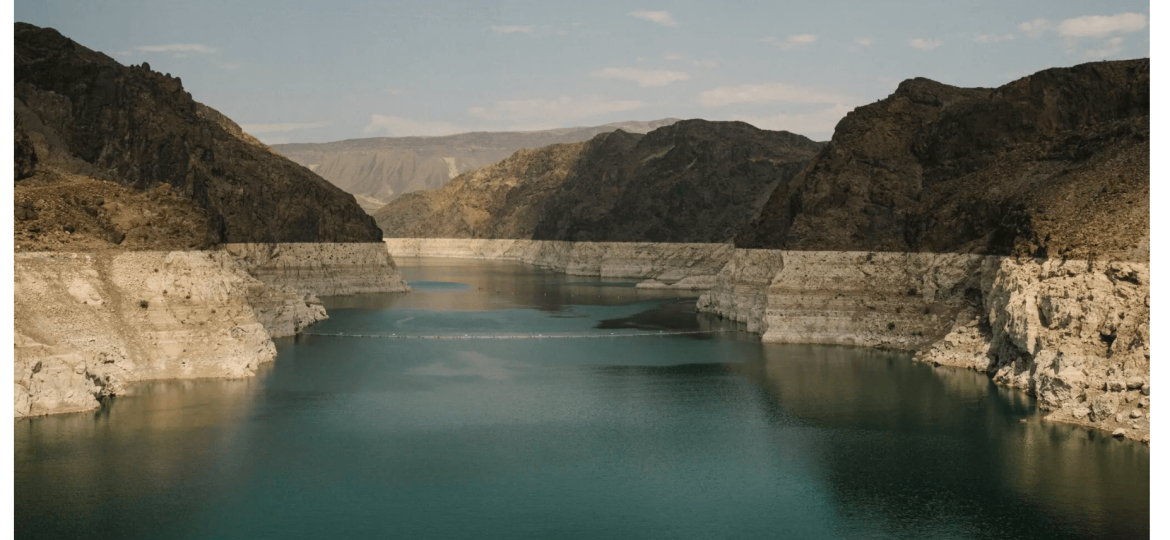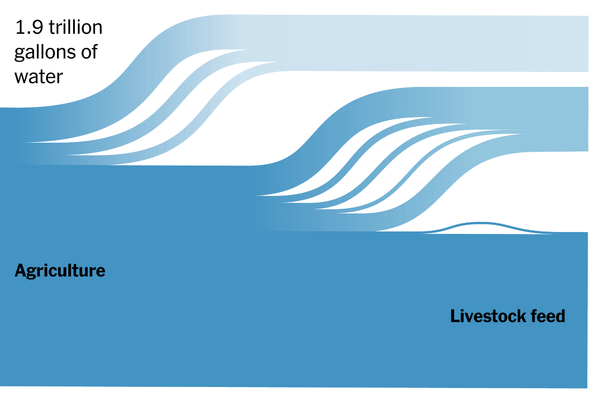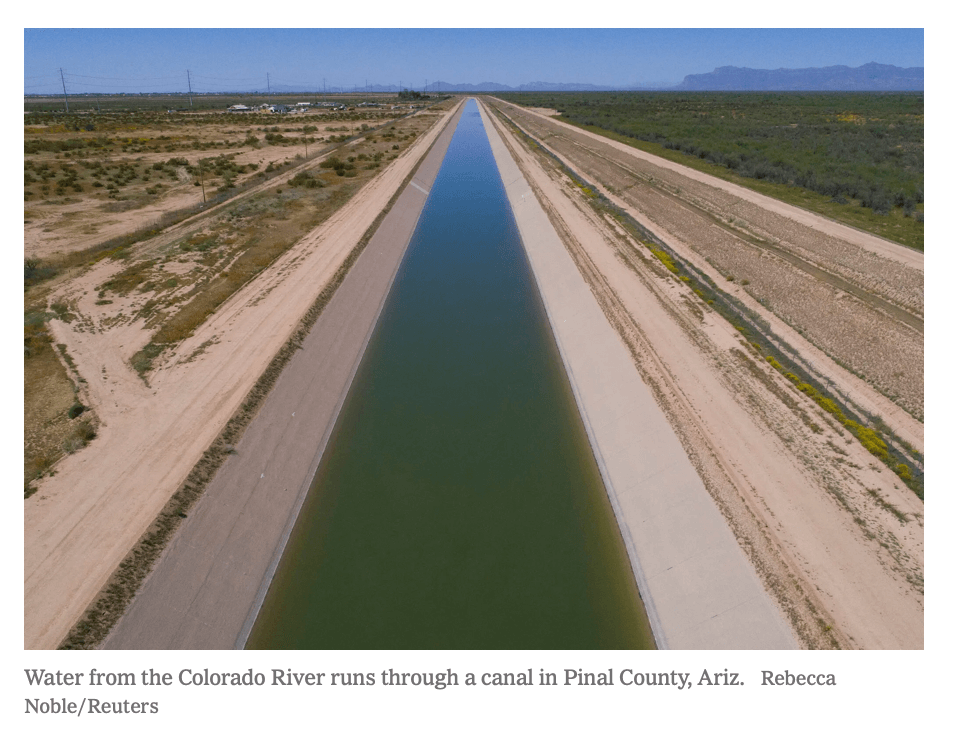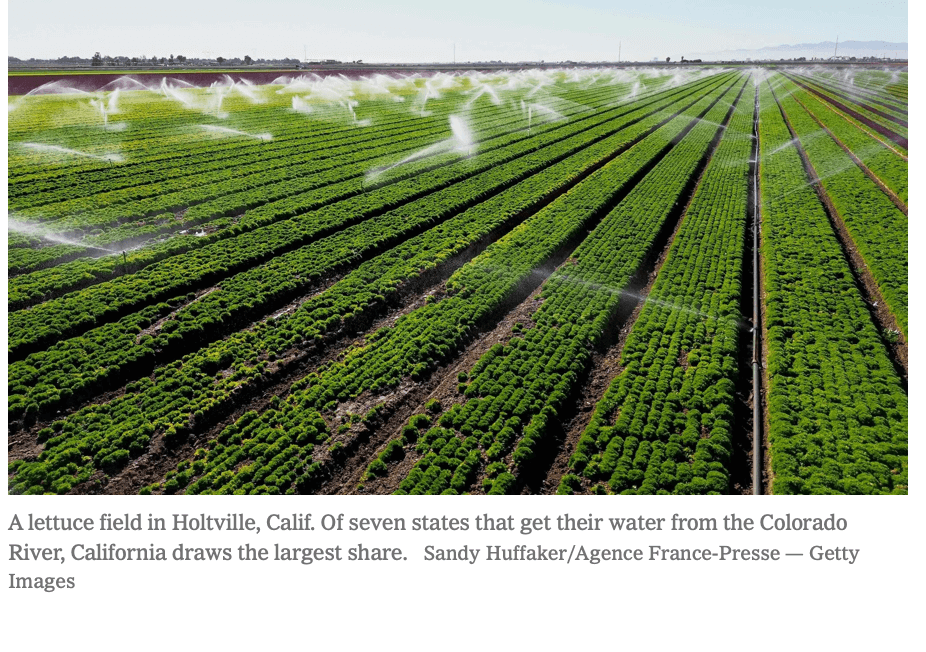
The agreement on cuts, aided by a wet winter and $1.2 billion in federal payments, expires at the end of 2026.
Arizona, California and Nevada have agreed to take less water from the drought-strained Colorado River, a breakthrough agreement that, for now, keeps the river from falling so low that it would jeopardize water supplies for major Western cities like Phoenix and Los Angeles as well as for some of America’s most productive farmland.
The agreement, announced Monday, calls for the federal government to pay about $1.2 billion to irrigation districts, cities and Native American tribes in the three states if they temporarily use less water. The states have also agreed to make additional cuts beyond the ones tied to the federal payments to generate the total reductions needed to prevent the collapse of the river.
Taken together, those reductions would amount to about 13 percent of the total water use in the lower Colorado Basin — among the most aggressive ever experienced in the region, and likely to require significant water restrictions for residential and agriculture uses.
The Colorado River supplies drinking water to 40 million Americans in seven states as well as part of Mexico and irrigates 5.5 million acres of farmland. The electricity generated by dams on the river’s two main reservoirs, Lake Mead and Lake Powell, powers millions of homes and businesses.
But drought, population growth and climate change have dropped the river’s flows by one-third in recent years compared with historical averages, threatening to provoke a water and power catastrophe across the West.

The Colorado River Is Shrinking. See What’s Using All the Water.
Hint: It’s less about long showers and more about what’s for dinner.
California, Arizona and Nevada get their share of water from Lake Mead, which is formed by the Colorado River at the Hoover Dam and is controlled by the federal government. The Bureau of Reclamation, an agency within the Interior Department, determines how much water each of the three states receives. The other states that depend on the Colorado get water directly from the river and its tributaries.
“This is an important step forward toward our shared goal of forging a sustainable path for the basin that millions of people call home,” Camille Calimlim Touton, the Bureau of Reclamation commissioner, said in a statement.
The agreement struck over the weekend runs only through the end of 2026 and still needs to be formally adopted by the federal government. At that point, all seven states that rely on the river — which include Colorado, New Mexico, Utah and Wyoming — could face a deeper reckoning, as its decline is likely to continue.
The negotiations over the Colorado were spurred by a crisis: Last summer, the water levels in Lake Mead and Lake Powell, the two largest reservoirs along the river, fell enough that officials feared the hydroelectric turbines they powered might soon cease operating.
There was even the risk that reservoir levels would fall so low, the water would no longer reach the intake valves that control the flow out of the lakes, essentially drying up the river downstream.
Facing that prospect, the Interior Department last June told the seven states to find a way to reduce their water use by two to four million acre-feet of water per year. (An acre-foot is roughly as much water as two to three households use in a year.) The states failed to reach an agreement, even as water levels in the two reservoirs remained dangerously low.
That inertia led the federal government to lay the groundwork for unilaterally imposing cuts on those states. Adding to the pressure, the Interior Department said last month that it might disregard the century-old rules governing which states should bear the brunt of cuts and instead come up with a different formula.
The federal government gave states until May 30 to take a position on the prospect of unilateral reductions. But behind closed doors, the Biden administration was negotiating with states to reach a deal and avoid having to impose cuts that would certainly face legal challenges and end up delaying any action.
Under the agreement announced Monday, most of the cuts, 2.3 million acre-feet, would come from water districts, farm operators, cities and Native American tribes that had agreed to take less water in order to qualify for federal grants offered under the 2022 Inflation Reduction Act. Those payments will total about $1.2 billion.
Another 700,000 acre-feet would come from California, Nevada and Arizona, which agreed to work out the cuts among themselves in the coming months. (Under the terms of the agreement, as much as 200,000 acre-feet of those cuts could qualify for compensation through other federal programs, but those arrangements have yet to be worked out.)
If the states don’t identify those 700,000 acre-feet in additional cuts, the Interior Department said it would withhold the water, a move that could face legal and political challenges.
Together, the reductions would save three million acre-feet over the next three and a half years, above and beyond existing agreements. That is far less, on an annual basis, than what the federal government had demanded last summer.
The Interior Department was able to negotiate less drastic cuts thanks to an unusually wet winter that provided snowpack levels in the Colorado Basin that are far above average, especially in California. That is expected to significantly increase the amount of water in the river, at least temporarily.
The terms of the deal were described to The New York Times by a senior official at the Interior Department who was involved in the negotiations, and who spoke on the condition that he not be identified by name. The Washington Post reported elements of the deal last week.
The structure of the agreement allows the Biden administration to sidestep, for now, the problem of which states will take the brunt of the cuts.
The Interior Department declined to provide a breakdown showing how much of the 2.3 million acre-feet in voluntary, federally compensated reductions would come from each state. And, finding the additional 700,000 acre-feet remains a problem for the three lower-basin states to solve.
As a result, what looked until recently like a state-against-state cage match has produced an outcome that is more tolerable for the states involved, if not exactly welcome.
The rules that govern the river, which date to 1922, say that much of Arizona’s supply from the Colorado River would be cut to almost zero before California experienced reductions. Though Arizona would still see its water supply reduced significantly, the deal effectively removes the threat of drastic slashes.
“I am very happy with this proposal,” Tom Buschatzke, director of Arizona’s Department of Water Resources and the state’s lead negotiator in the talks, said on Monday. “I think there is a lot of equity in it.”
Sarah Porter, the director of the Kyl Center for Water Policy at Arizona State University, called the agreement a positive step, but one that might only offer a stay of execution. “Before 2026 we could be back in that danger zone again,” she said.
California also fares better than might otherwise have been the case. The Interior Department raised the prospect of cutting each state’s supply equally, as a share of its total use. Because California uses more water from the Colorado than any other state, it would have lost the most — a shock to farmers in Southern California, as well as cities like Los Angeles and San Diego. Relying largely on voluntary reductions gets around that concern.
Bill Hasencamp, manager of Colorado River resources for the Metropolitan Water District of Southern California, said the agreement could provide a few years of stability for Los Angeles, San Diego and other California cities that rely on water from the Colorado.
The greater challenge will be reaching a deal after 2026, when the federal government may not be willing to provide as much funding to conserve water, and states won’t be able to count on more winters of heavy rain and snowfall. “We know that the future is going to be drier than the past,” Mr. Hasencamp said.
The deal is also a victory of sorts for the Biden administration, which has at times appeared unsure how to respond to the growing crisis. In the past year, it twice set deadlines for the states to come to an agreement, which they failed to meet. The Interior Department said the agreement shows that states are able to work together with the federal government to address the challenge of the Colorado’s decline.
That notion, too, will soon be tested. The department has said its next step will be to study the effects of the deal that states have struck, before deciding how to proceed. In the meantime, the next round of negotiations, about what to do after 2026, are set to begin next month.
Jack Healy contributed reporting from Phoenix.


